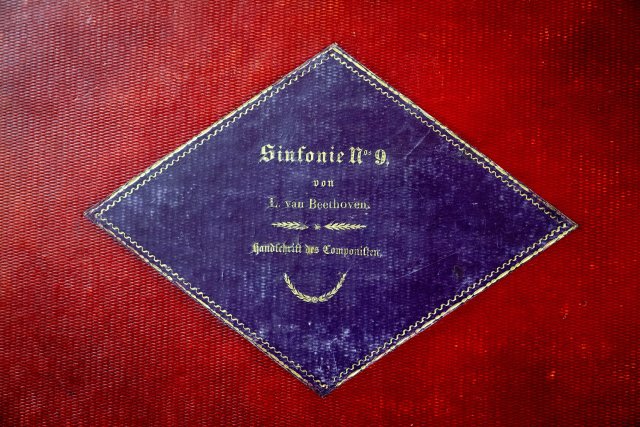How it all began: The bound “Manuscript of the Symphony No. 9 by the composer L. van Beethoven”
Photo: dpa
On May 7, 1824, Beethoven’s 9th Symphony in D minor, Op. 125, was premiered in the Vienna Theater am Kärntnertor. If one can trust the contemporary sources, the audience’s reaction was quite positive, almost euphoric – that of the reviewers and other composers was rather ambivalent. For Richard Wagner it was Ninth “the human gospel of the art of the future”, Louis Spohr, on the other hand, found the fourth movement in particular “monstrous and tasteless” and came to the conclusion that Beethoven lacked “aesthetic education and a sense of beauty”. Giuseppe Verdi remarked that the finale was “poorly placed.” And even Leonard Bernstein, who was quite sympathetic to pathetic performances, dissed the finale of the Ninth as “coffee house music”.
When you talk about Beethoven Ninth speaks or writes, you definitely have to differentiate. Because what is usually meant is the final movement, the finale with the “Ode to Joy”, i.e. the pathetic “Joy of beautiful sparks of the gods”. The first movement is one of Beethoven’s best symphonic works – but hardly anyone talks about it (except for outstanding conductors like Michael Gielen or Vladimir Jurowski). But everyone loves the finale: Wagner, Hitler, Stalin, NATO, the EU, everyone. When Rhodesia’s racist apartheid rulers were looking for a national anthem in 1974, the military commander created a 16-bar short version – while NATO had already declared the “Joy Melody” to be its official overall anthem in 1967.
How is it that a work that was played on March 18, 1905 in front of 3,000 workers in a Berlin brewery hall, later the Friedrichshain hall, in memory of the victims of the revolution of 1848 and has been performed regularly since 1909 at the Vienna Workers’ Symphony Concerts (ASK) was listed, got into such dubious waters?
It is, after all, a symphony that was seen by Kurt Eisner, the leader of the Munich November Revolution of 1918 and President of the Munich Soviet Republic, as a symbol of a socialist utopia; a piece of music that Hanns Eisler had speculated in 1927, that after the “victory over the ruling class, the millions of those who had been oppressed until then would cheer with Beethoven’s triumphant song”: “Be embraced, millions!”
This music has a pathos problem. The pathos of Beethoven’s overwhelming music can easily be abused. Adorno wrote succinctly in his late Beethoven book, which remains a fragment: “Hitler and the IX. Symphony: Be surrounded, millions!” And explained elsewhere: “Works of the Ninth Symphony type exert suggestion: the violence that they achieve through their own structure spills over into the effect. In the development that followed Beethoven, the suggestive power of the works, originally borrowed from society, was reflected back on society, becoming agitational and ideological.” Or, simply: “Some of Beethoven’s very great pieces only sound boom boom from a distance.”
Beyond all the Wagner adoration of Hitler: the musical hero of the Nazi state was Ludwig van Beethoven, he was homaged, he was considered the ideal folk composer, and no other composer was played in public as often as Beethoven, and especially when His music could be used as encouragement during the war. Next to the Fifth No other work was performed as frequently during National Socialism as this one Ninth. The National Socialists were particularly fond of it: in 1933, the chief NS ideologist Alfred Rosenberg compared the onslaught of Hitler’s followers with the battle cry of the Nazis Ninth: “Joyful, like a hero to win!” And on the evening of the opening day of the Berlin Olympic Games in 1936, Hitler had the choir finale Ninth intoned by almost 6,000 teenagers, “the bells rang and the anti-aircraft gun’s searchlights heaved a dome of light into the sky – the Ninth à la Riefenstahl” (Klaus Umbach). The following year the Ninth Performed for the first time on Hitler’s birthday at the behest of Goebbels, Furtwängler conducted, and it became a tradition.
In 1972, the “Ode to Joy” became the “European anthem” by decision of the Committee of Ministers of the Council of Europe. The commission for the “musical design” was given to Herbert von Karajan, who sung the original bars 140 to 187 of the final movement of the Ninth transformed into a pure orchestral movement and with this small intervention the copyright to both the score of the “European Anthem” and the recording, which was released by Deutsche Grammophon (with whom Karajan had already had a lucrative contract since 1938) and thus the secured considerable profits from their exploitation. As is well known, Herbert von Karajan was so convinced of National Socialism that he joined the NSDAP twice, in 1933 and again in 1935.
You can let this sink in, especially in times when there are constant myths about supposed “firewalls” against the right: The EU plays an anthem at every official event that was written by a former Nazi. It just goes boom, boom.
Become a member of the nd.Genossenschaft!

Since January 1, 2022, the »nd« will be published as an independent left-wing newspaper owned by the staff and readers. Be there and support media diversity and visible left-wing positions as a cooperative member. Fill out the membership form now.
More information on www.dasnd.de/genossenschaft
